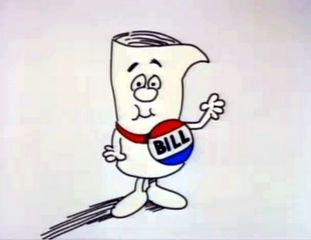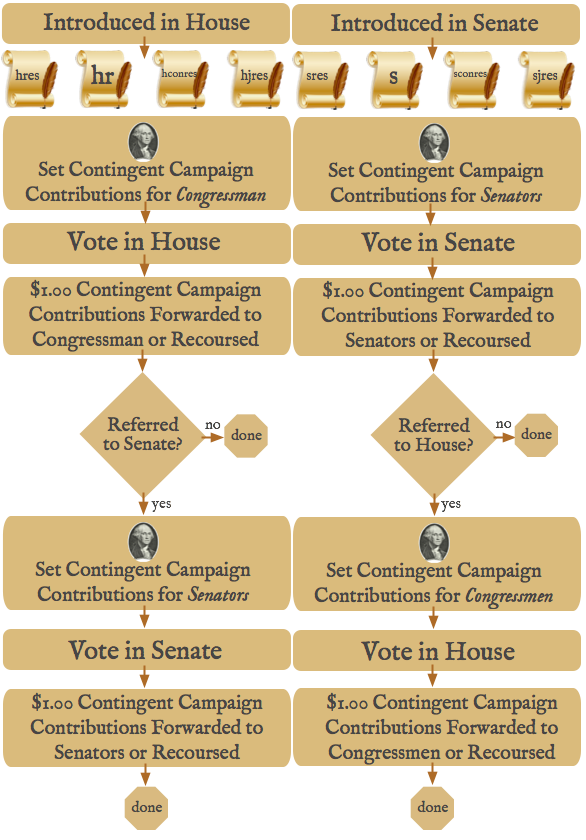Take Back Government
How a Bill Becomes a Law
In order to use TakeBackGovernment.com effectively, and make Contingent Campaign Contributions where they can do the most good, it helps to understand how a bill becomes a law.
In Case You Need a Refresher
If you're of a certain age, you probably remember this fellow from SchoolHouse Rock. Follow this link if you were absent the day they showed it in school.

Types of Bills
When you use TakeBackGovernment.com to express your opinions, you'll notice that there are two types of documents moving through Congress. They are "bills" and "resolutions." With several sub-types, they are uniquely identified by a document type, a number, and a Congress. For example, "hr1234-115" is the 1,234th bill that started in the House of Representatives during the 115th congress (which opened on January 3, 2017).
Two of these document types, indicated by the prefixes "hr" or "s" are bills that have the potential to become laws. "hr" bills start in the House of Representatives, while "s" bills start in the Senate. Both have to be passed by both chambers before they can go to the President for his signature, and become law.
The others, indicated by the prefixes "hres," "hconres," "hjres," "sres," "sconres," and "sjres" are called resolutions, of which there are three types. Simple resolutions ("hres" and "sres") only get a vote in their originating chamber. Concurrent resolutions ("hconres" and "sconres") get a vote in both chambers but do not go to the President. Neither has the force of law. Joint resolutions "hjres" and "sjres") on the other hand, can be used either to propose an amendment to the constitution or to propose a law. When used to propose a law, they have exactly the same procedural steps as bills.
So four types of bills, "hr," "hjres," "s" and "sjres", can become laws. Note also that each Congress lasts two years. All bills die at the end of the Congress. And the numbering system starts over with the new Congress.
| Types of Bills | |||||
| Abbrev / Example | Stands for | Type | Voted In | Can Become Law? | |
|---|---|---|---|---|---|
| hr | hr1234-115 | House of Representatives | Bill | Both Chambers | Yes |
| hres | hres1234-115 | House Simple Resolution | Resolution | House Only | No |
| hconres | hconres1234-115 | House Concurrent Resolution | Resolution | Both Chambers | No |
| hjres | hjres1234-115 | House Joint Resolution | Resolution | Both Chambers | Yes |
| s | s1234-115 | Senate | Bill | Both Chambers | Yes |
| sres | sres1234-115 | Senate Simple Resolution | Resolution | Senate Only | No |
| sconres | sconres1234-115 | Senate Concurrent Resolution | Resolution | Both Chambers | No |
| sjres | sjres1234-115 | Senate Joint Resolution | Resolution | Both Chambers | Yes |
Types of Votes and Outcomes
Although you can use TakeBackGovernment.com without knowing the details of congressional voting, this section is included in case you want to understand the process more completely. It can also help you understand how and when your Contingent Campaign Contributions will be set to be paid (i.e. forwarded to your representative) or recoursed (i.e. forwarded to a competitor for the seat or returned to your account).
There are four ways that Congress can dispose of, or vote on, a bill:
- Roll Call - In this type of vote, the "yea" or "nay" vote of each member of the House or Senate is recorded. TakeBackGovernment.com compares the vote of the individual representative to your position on the bill to determine payment or recourse.
- If you wanted the representative to vote "for the bill," and the representative voted "yea," they will get your Contingent Campaign Contribution.
- If you wanted the representative to vote "against the bill," and the representative voted "yea," your Contingent Campaign Contribution will be recoursed.
- If you wanted the representative to vote "for the bill," and the representative voted "nay," your Contingent Campaign Contribution will be recoursed.
- If you wanted the representative to vote "against the bill," and the representative voted "nay," they will get your Contingent Campaign Contribution.
- Voice Vote - On a voice vote, the presiding officer first asks those in favor to say "aye," and then asks opposed to say "no." The presiding officer then announces who appeared to win the vote. In this case, since we cannot know how a particular representative voted, payment or recourse is determined by the outcome.
- If you wanted the representative to vote "for the bill," and the bill passed, they will get your Contingent Campaign Contribution.
- If you wanted the representative to vote "against the bill," and the bill passed your Contingent Campaign Contribution will be recoursed.
- If you wanted the representative to vote "for the bill," and the bill failed to pass, your Contingent Campaign Contribution will be recoursed.
- If you wanted the representative to vote "against the bill," and the bill failed to pass, they will get your Contingent Campaign Contribution.
- Without Objection - This is a variation of the Voice Vote, and thus it is treated the same as a Voice Vote.
- Unanimous Consent - This is another variation of the Voice Vote, and thus it is treated the same as a Voice Vote.
TakeBackGovernment does not consider what happens to a bill once it has passed (or failed) in Congress (i.e. whether the President signs the bill on not.) Payment or recourse is designed only to influence Congressional voting.
Influencing the Process with TakeBackGovernment.com
When you see or hear about a bill you're interested in, if it has not already passed then you can make a Contingent Campaign Contribution to a representative in the Chamber where it's being debated in order to try to influence their vote. If it is a bill or resolution that was introduced in the House, and it has not yet passed in the House, you will be presented with a list of Congressional representatives. If it is a bill or resolution that was introduced in the Senate, and it has not yet passed in the Senate, you will be presented with a list of Senators.
After there has been a vote in the originating Chamber on the bill or resolution, your Contingent Campaign Contribution will be forwarded to your representative or recoursed, depending on your position and how your representative voted (or, in the case of non-roll call votes, how the chamber voted). And you will no longer be able to make a Contingent Campaign Contribution on that bill for a representative in that Chamber.
In cases where bills or resolutions require action in the other Chamber (i.e. for hr, hconres, hjres, s, sconres and sjres types) after it has passed in the originating Chamber, you will be then presented with a list of representatives from that other Chamber, to whom you can make a new Contingent Campaign Contribution in order to try to influence their vote.
After there has been a vote on the bill or resolution in that second Chamber, your new Contingent Campaign Contribution will be forwarded to your representative or recoursed, again depending on your position and how your representative voted. And you will no longer be able to make a Contingent Campaign Contribution on that bill for a representative in that chamber.
Note that there are circumstances where a bill may get debated again in either or both chambers after having passed in both chambers. This can happen if the chambers passed different versions of the bill, and they need to agree on the final version that will be sent to the President, for example. Because this process often happens very fast, it may not be possible for the system to be re-opened so you can make Contingent Campaign Contributions on the reconciliating bill, however your opinions on the original bill will still be visible.
So overall, the process looks like this:

As you can see, by making Contingent Campaign Contributions to representatives on bills you care about (what we refer to as "Dropping a George") you can influence your representatives' votes much more directly, effectively and visibly than calling them or donating through organizations whose positions you may not always agree with.
